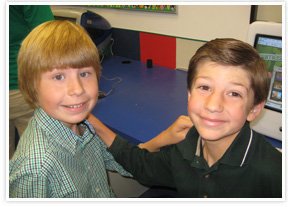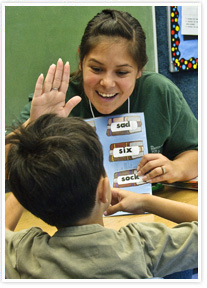The Children’s Workshop curriculum is built from three sources: (a) the best of several published curricula for young children, including young children with autism; (b) the Individualized Education Plan (IEP) goals that we have developed during the history of the program; and (c) our own observations concerning what skills our students need in order to be successful in less-restrictive school environments, in the community, and in their homes with their families.
A curriculum of 12 strands for the “whole child”
We have designed a category system of 12 curricular areas or strands, which has proved to be desirable in part because it causes us to evaluate the “whole student” and create a plan to encourage the child’s development in all the areas as necessary.
-
- 1. Observation & Attending—ranging from responding to the presence of others to sustained attending and joint attention
- 2. Generalized Motor Skills—ranging from basic gross motor coordination to fine manual skills and oral and lingual skills essential to eating and speaking
- 3. Imitation—ranging from imitating simple bodily movements to imitating manipulation of objects to imitating sound patterns to imitating complex movements
- 4. Receptive Language—ranging from response to safety commands, to following complex instructions, to learning adventitiously
- 5. Expressive Language—ranging from getting basic needs met by others to conversing with others to teaching or informing others
- 6. Play Skills—ranging from fundamental play with action toys to socio-dramatic play to complex games with others
- 7. Self-Help—ranging from washing hands to toileting to organizing materials for an activity
- 8. Social Skills—ranging from tolerating the presence of others to helping others to prolonged positive interaction with others to displaying emotions to others
- 9. Reinforcer Parameters—ranging from acquiring new skills only with edible or tangible reinforcers delivered on each trial to acquiring new skills only with social reinforcers given infrequently
- 10. Inappropriate Behaviors—the only category in our curriculum that includes behaviors that need replacing; ranging from severe tantrums and assaultive behavior to echolalia and stigmatizing repetitive behavior patterns
- 11. Learner Skills—ranging from looking at the teacher to brief periods of learning readiness behavior to prolonged learning readiness behavior to learning without being specifically taught
- 12. Pre-academics and Academics—ranging from basic conditional discriminations to learning from text, writing sentences, performing simple arithmetic calculations and so on
For each of these curriculum areas we have a rationale, subcategories, and a skills list. The methods and procedures essential to teach all skills are individualized for each student.
Methods
We use the principles and methods of Applied Behavior Analysis (ABA) to design and evaluate our interventions, which include, but are not limited to the following:
Discrete Trial Teaching, Incidental & Naturalistic Teaching, Fluency Building, Video Modeling, Conditional Discrimination Training, Activity Schedules, Verbal Behavior, Functional Communication Training, Direct Instruction, Functional Analysis and Functional Assessment, Behavior Intervention Planning, Data Based Decision Making.
Click for more information on ABA.
Related Services Model
CW employs both a licensed speech pathologist and a registered occupational therapist. We have adopted an integrated model to implement their services. The specialists train the professional and paraprofessional personnel on how to implement therapy relevant tasks throughout the school day. This allows for many more opportunities for our students to practice these skills than would occur in a “pull-out” model.





